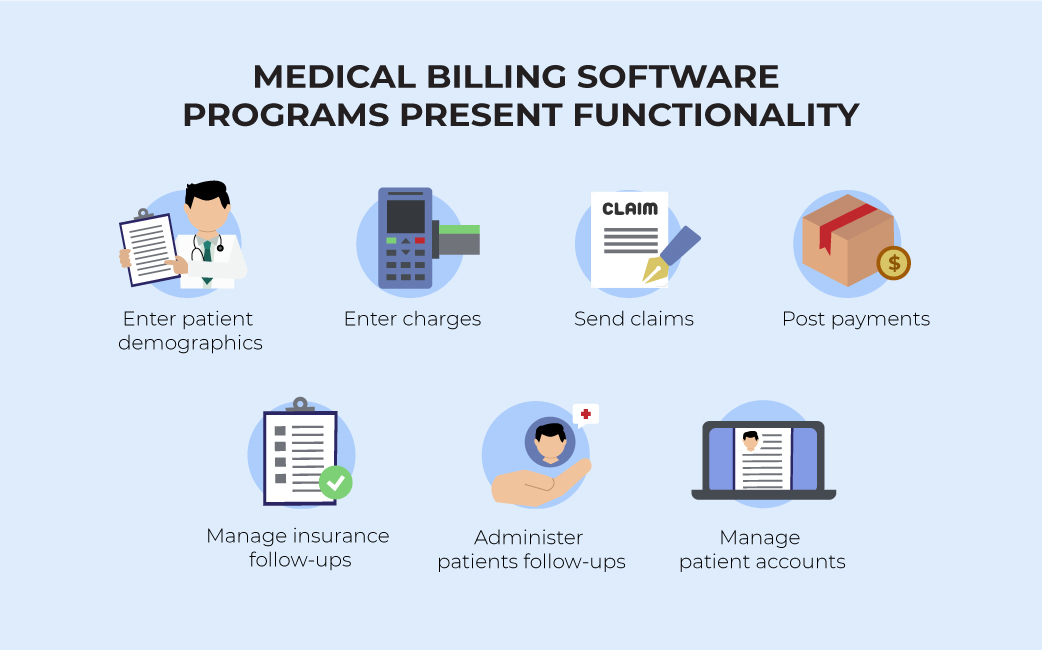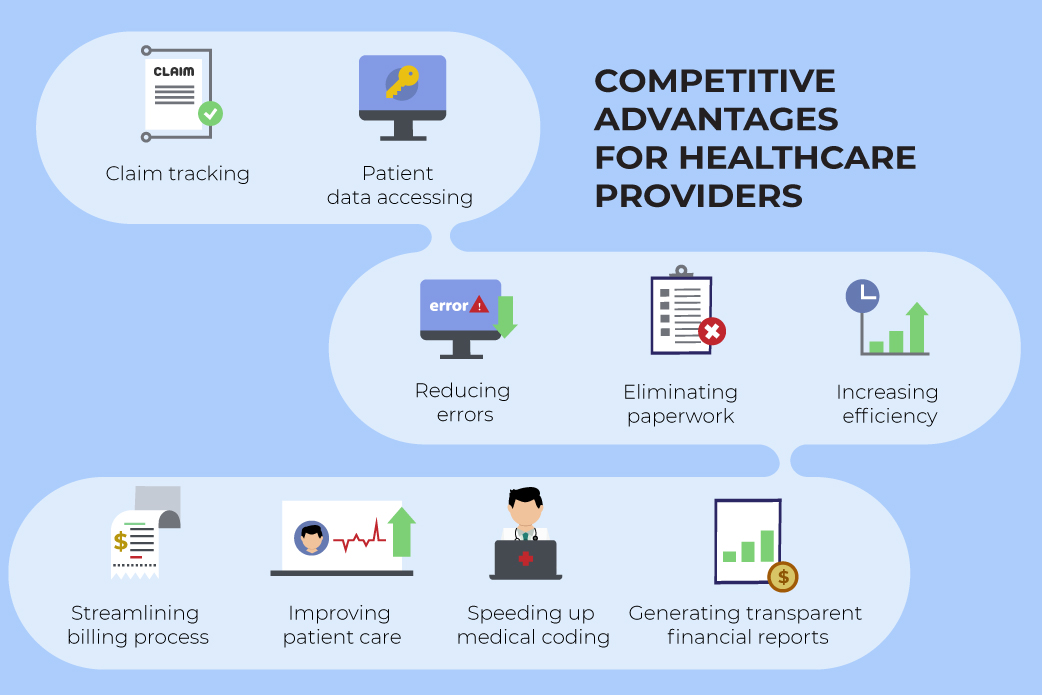Medical Billing And Coding Software: Benefits and Challenges

Medical Billing and Coding Software Programs: Definition and Description
With the average time turnaround between filing a claim and getting payments reaching up to 7(!) weeks and over, the demand for cost-effective and efficient medical billing solutions comes as no surprise.
The employment trends in this sector shine a light on the future of medical billing and coding (MB&C) software. In particular, it is expected that hiring for medical coders and billers can grow by 8% in the period from 2019 to 2029.
Payments errors and billing inefficiency that customers face are often the results of insufficient medical coding. Hence, among multiple benefits of MB&C software usage, the major one refers to the capability to reduce the number of errors and claim denials.
Medical Billing Software and Medical Coding Software
Overall, medical billing software programs present functionality that allows medics to
Enter patient demographics
Enter charges
Send claims
Post payments
Manage insurance follow-ups
Administer patients follow-ups
Manage patient accounts

Furthermore, billing insurance medical software allows to pull EOB (explanation of benefits), a notice that gives a summary of claims (for instance, prescription claims), and costs. It includes the information on a payee, a payer, and a healthcare customer (patient).
While most medical software can be applied universally, some remains specialty-specific (for instance, Helper). We’ll discuss the examples of the best billing and coding software programs below.
Medical coding introduces the insurer to the story of the patient encounters with the provider. It includes relevant details for billers:
Date of service
CPT codes that describe the product or services provided
Modifiers that add clarifying detail on CPT
The diagnosis code, which contains information on the patient’s problem
Online coding tools are built around ICD-10 that contains 14000 codes.
As a side note, ICD-11 has over 55000 relevant codes introducing an expanded list of diagnoses. Updated ICD-11 was adopted by the World Health Assembly in May 2019 and is expected to be put into practice in January 2022.
The Bottom Line: Medical billing software programs assist in getting all the information on how payments are applied.
Medical coding programs are a predefined set of codes that help streamline billing and send it to insurers.
AI-Driven Solutions in Medical Billing and Coding Software
The impact of AI on the healthcare industry made it out to MB&C software programs.
At present, there are lots of AI-empowered solutions that can:
analyze the doctor’s treatment documentation
automatically recognize the relevant medical codes
autocorrect medical codes
build chatbots to reply to patients’ questions on insurance claims
automate recurring tasks associated with coding and billing
provide pre-authorization required for certain medical conditions and stated in insurance policies
Processing a high volume of data means that AI-based solutions assist in decreasing work hours as well as reducing human errors. Notes, lab results, and reports crucial for transparent billing are encoded allowing to pull medical codes instantly. Upon a review, billing information is sent to a healthcare customer.
The Bottom Line: AI not only shapes the current status of the medical billing segment but becomes one of the driving forces in accelerating the digitalization of coding.
Medical Billing Process
Medical billing workflow starts with collecting information from the medical practice.
The process implies that healthcare professionals enter the charges, and process the claims. It is followed by posting co-payments and insurance payments, sending the patient statements, running reports to complete insurance billing, follow-up, and practice.
Medical coding takes place at the stage of collecting patient information and billing data.
There are various types of medical billing systems.
Aside from differing individual (conducted by a person) and institutional (referring to payments by and within healthcare organizations) types of billing systems, the most comprehensive three types of medical billing and coding systems are based on payment transfer functionality.
They are closed, open, and isolated types of medical billing systems. Closed types are limited in their billing functionality because the transfers are not allowed. This software functions as the means of information accumulation for further payments.
In an open system, transfers are allowed. EHR software is one of the most popular open hospital billing software. They elevate collaboration on billing and payment processing to a new level and enable medical professionals and insurance companies to access relevant information in real-time.
An isolated system is exclusively patient-centric as all the transfers are initiated by patients as holders of their healthcare records. These systems are custom designed and address patients’ privacy concerns at best. Even though personal health records are an emerging information technology in healthcare, they do not hold the status of the official document yet.
Benefits of Using Medical Billing Software and Coding Programs
Medical billing software programs accelerate payments on all tiers of healthcare organizations and minimize the number of errors in claim processing. Medical coding, aside from streamlining the billing process, helps maintain the privacy of patient diagnosis data.
Therefore, medical billing & coding software will be highly beneficial for the following categories of users:
Healthcare professionals
Reception staff
Medical billing service providers
Healthcare systems managers
Insurance businesses
Healthcare providers
Patients as invoiced payers

Upon the implementation of the MB&C software, healthcare providers have the opportunity to get a competitive advantage in:
Claim tracking
Patient data accessing
Eliminating paperwork
Reducing errors
Increasing efficiency
Improving patient care
Generating transparent financial reports
Streamlining billing process
Speeding up medical coding
The Bottom Line: Medical claims management within a hospital management system gets facilitated with the implementation of custom healthcare solutions. They remove the burden of administrative routine: medical professionals do not have to deal with the paperwork involved in patient diagnosis, treatments, or any piling up issues in medical coding and medical billing.
Examples of the Best Medical Billing Software
Though the software comes in different costs and functionality, it generally meets multiple requirements of the billing process. Below, we list key players among the best medical billing software that deliver full-fledged solutions in simplifying billing management.
It is an example of billing software for a home-based business that is reasonably priced and offers great technical support.
The navigation within software not only saves you time on screen taps and mouse clicks but enables medical professionals to enter patient’s information in detail, including diagnosis code, a referring provider, insurance company, etc.
Bringing any underlined field means that an authorized medical professional can see, edit or change it instantly. In case a patient or healthcare provider needs a printed set of documents it can be done within the program too. Insurance claims can be viewed or sent as well. Charges, adjustments, payments, and additional notes are presented in color codes for optimized search.
Pricing detail is available upon vendor request.
Summing up, TotalMD is a one-fit-it-all software program to collect data and manage payments, arrange patients’ schedules, and provide timely payment solutions.
It is a solution specially designed for medical healthcare organizations and medical practice owners. Its feature set consists of a practice management module, EHR, medical billing and coding module, and functionality providing financial analytics for the billing workflow automation.
It ensures seamless medical billing for smaller practices and empowers medical professionals and insurance companies. AdvancedMD works as an extension of medical practice.
In the case of choosing a fully integrated plan, the price will be $729 per provider per month.
Summing up, AdvancedMD is medical billing software that features options for medical billing, including diverse communication tools for reaching patients and medical practitioners in real-time for clarification of the service.
Kareo belongs to the list of medical billing software programs that leverage software functionality to reduce paperwork and claim tracking in the billing process.
It offers cloud-based clinical management and features handling of patient information, medical patient scheduling options, and built-in communication tools and reminders.
Insurance companies and billing parties get access to relevant data in real-time and get notified of any upcoming payments.
Kareo Billing price starts from $110.00 per month.
Summing up, Kareo Billing is one of the leading software on the medical billing market and finds wide usage as scheduling software.
It is a HIPAA-compliant tool that best suits chiropractic businesses and performs as a superb solution for easy patient scheduling as well as billing and payment processing.
Aside from automated scheduling, it offers billing, invoicing, and calendar synchronization to keep up with payments. Capacity management and attendance tracking facilitate medical and wellness organization workflows and contribute to effective revenue cycle management.
Vagaro costs $25.00 per feature monthly.
Summing up, Vagaro will be a good choice of billing software for healthcare and wellness businesses.
It is one of the best medical billing electronic claims software. It delivers integrated EHR solutions, featuring practice management options, diverse billing services, medical coding, and revenue cycle management. The software introduces patient charts, medical billing, appointment reminders, and scheduling.
The pricing information is available upon submitting a request to the vendor.
Summing up, WRSHealth is an ideal fit for a healthcare business of any size due to insurance eligibility verification and providing access to invoice history.
Things to Consider
Potential issues in choosing and implementing medical billing & coding software are related to a number of aspects.
One of the challenges relates to protecting sensitive health data under the norms of existing acts and policies. For instance, HITECH Act and HIPAA compliance are must-haves in proceeding with the implementation of medical billing & coding systems. At a minimum, it requires professional consultation to embark on national standards ensuring patient health and financial data protection.
Due to the coming release of IDC-11, the software will need to keep updated to comply with the medical coding.
MB&C software programs imply usage by multiple parties involved in the process. It means that you need highly integrated solutions as well as means for conducting effective communication with government bodies, medical practice owners, and insurance companies.
The medical billing & coding software requires a learning curve in training staff for making the best use of it.
The Bottom Line: To address the potential issues with implementing and using medical billing & coding software, it is worth considering the collaboration plan with a reliable software vendor.
Key Takeaways
Medical billing & coding software ensures seamless functioning of healthcare organizations in alliance with insurance companies and other institutions involved in a medical billing process.
MB&C software performs a myriad of functions including insurance reimbursements, streamlining invoices and payments, tracking claims, automating recurring accounting tasks, scheduling, diverse reporting, patient information management.
Prioritizing patient billing data security when building medical billing software solutions sets a high standard in ranking your healthcare business and contributes to creating a sustainable revenue cycle.
Build your ideal
software today


